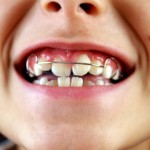
Tooth crowding results due to a lack of space for teeth to erupt can occur in both the primary and permanent dentitions. This can be because of a mismatch between the size of jaws and teeth or because of lack of space due to early loss of primary teeth because of caries or trauma. A number of different orthodontic interventions in both primary and mixed and permanent dentitions have been suggested to correct or prevent crowding
The aim of this Cochrane review was to assess the effects of orthodontic interventions for preventing or correcting crowded teeth in children.
Methods
Searches were conducted in the Cochrane Oral Health’s Trials Register, Cochrane Central Register of Controlled Trials (CENTRAL), Medline, Embase, ClinicalTrials.gov and the WHO International Clinical Trials Registry Platform. Randomised controlled clinical trials (RCTs) of orthodontic treatments to prevent or correct crowded teeth where one intervention was compared concurrently to a placebo, no intervention, or another method to prevent or correct dental crowding were considered. Two reviewers independently and in duplicate extracted and assessed study quality using standard Cochrane methodology. Continuous data was presented as mean differences (MDs) with 95% confidence intervals (CI) and dichotomous data as and odds ratios (ORs) with 95% CIs. Meta-analyses were conducted when studies of similar comparisons reported comparable outcomes.
Results
- 24 RCTs involving 1512 patients were included
- 23 studies were considered to be at high risk of bias and one at unclear risk
- 17 comparisons were investigated, 20 studies evaluated fixed appliances and auxiliaries (lower lingual arch, lower lip bumper, brackets, archwires, lacebacks, headgear and adjunctive vibrational appliances); Removable appliances and auxiliaries (Schwarz appliance, eruption guidance appliance) were assessed in 2 studies with 2 studies evaluating dental extractions.
- Most interventions were evaluated by a single study.
- The evidence is of very low certainty so it should be interpreted cautiously.
Fixed appliances and auxiliaries
- 1 study (34 patients) found using a lip bumper may reduce crowding in the early permanent dentition, MD= −4.39 mm (95%CI; −5.07 to −3.71).
- 1 study (24 patients) concluded that coaxial nickel-titanium (NiTi) archwires may cause more tooth movement in the lower arch than single-stranded NiTi archwires, MD = 6.77 mm (95%CI: 5.55 to 7.99).
- 1 study (66 patients), comparing copper NiTi versus NiTi archwires, found NiTi to be more effective for reducing crowding, MD = 0.49 mm (95%CI: 0.35 to 0.63).
- Single studies did not show evidence of one type of archwire being better than another for Titinol versus Nitinol; nickel-titanium versus stainless steel or multistrand stainless steel; and multistranded stainless steel versus stainless steel.
- Nor did single studies find evidence of a difference in amount of crowding between self-ligating and conventional brackets, active and passive self-ligating brackets, lacebacks added to fixed appliances versus fixed appliances alone, or cervical pull headgear versus minor interceptive procedures.
- Meta-analysis (2 studies, 119 patients) showed no evidence that adding vibrational appliances to fixed appliances reduces crowding at 8 to 10 weeks, MD = 0.24 mm (95%CI: −0.81 to 1.30).
Removable appliances and auxiliaries
- 1 study (28 patients) found use of the Schwarz appliance may be effective at treating dental crowding in the lower arch, MD = -2.14 mm (95%CI: −2.79 to −1.49).
- 1 study (46 patients) found an eruption guidance appliance may reduce the number of children with crowded teeth after one year of treatment, OR = 0.19 (95%CI: 0.05 to 0.68); however, this may have been due to an increase in lower incisor proclination in the treated group. Whether these gains were maintained in the longer term was not assessed.
Dental extractions
- 1 study (83 patients) found that extracting children’s lower primary canines had more effect on crowding after one year than no treatment, MD = −4.76 mm (95%CI: −6.24 to −3.28), but this was alongside a reduction in arch length.
- 1 study (77 patients) found that extracting wisdom teeth did not seem to reduce crowding any more than leaving them in the mouth, MD = −0.30 mm (95%CI: −1.30 to 0.70).
Conclusions
The authors concluded: –
Most interventions were assessed by single, small studies. We found very low-certainty evidence that lip bumper, used in the mixed dentition, may be effective for preventing crowding in the early permanent dentition, and a Schwarz appliance may reduce crowding in the lower arch. We also found very low-certainty evidence that coaxial NiTi may be better at reducing crowding than single-stranded NiTi, and that NiTi may be better than copper NiTi. As the current evidence is of very low certainty, our findings may change with future research.
Comments
Cochrane’s reviewers identified 24 RCTs that met the criteria for this review. However almost all of them were at high risk of bias mainly due to the fact that blinding of patients and personnel is not possible. While blinding of the outcome assessors would be possible only 12 studies did this. A wide range of interventions were tested including lower lip bumpers, cervical pull headgear, lower lingual arch, different types of brackets, different types of archwire, lacebacks and vibrational appliances, the Schwarz appliance and eruption guidance appliance and the extraction of primary canines. Although very few were tested in more than one study so only 4 meta-analyses each including two studies were conducted. As a consequence, the overall level of certainty of the evidence is very low so there is a a need for more long- term, well-designed RCTs reported in line with CONSORT and ideally using common outcome sets (COMET) to provide better evidence to assess preventive interventions and treatment options for crowded teeth in children
Links
Primary Paper
Turner S, Harrison JE, Sharif FN, Owens D, Millett DT. Orthodontic treatment for crowded teeth in children. Cochrane Database Syst Rev. 2021 Dec 31;12:CD003453. doi: 10.1002/14651858.CD003453.pub2. PMID: 34970995.
Other references
Cochrane Oral Health Blog – What is the best treatment for children with crowded teeth?
